The best plants for clay soil. Clayey soils are considered the most fertile soil for growing plants. There are very few natural lands that are enriched with fertile clayey soil.
Over the past century, gardeners, farmers, and hobbyists have been using imported clayey soils from various world regions.
According to geologists, areas near the sea and river are rich in fertile clayey soil.
Clayey soil has a higher water retention capacity due to finer sand particles.
Many gardeners prefer having a bulk of clayey soil in their gardens and fields for planting various plant species that grow well in clay.
Clay soil can be separated into clay, silty clay, clay loam, sandy clay, silty clay loam and sandy clay loam according to the University of Utah State.
Soil that contains more than 20% clay usually carries the addendum loam.
Continue reading to find out about the 40 best plants for clay soil.
40 Best Plants for Clay Soil
- Bearded Iris
- Daylily
- Lilac
- Hosta
- Weigela
- Black Eyed Susan
- Coneflower
- Potentilla
- Bee Balm
- Lantana
- Petunia
- Salvia
- Goatsbeard
- Sedum
- Aronia
- Rose of Sharon
- Helenium
- Hardenbergia Violacea
- Indigofera Australis
- Grevilla x Gaudichaudii
- Phlox
- Geranium
- Hydrangea
- Heuchera
- Big Bluestem
- Blazing Star
- Butterfly Weed
- Canadian Wild Rye
- Compass Plant
- Cup Plant
- Drooping Coneflower
- Indian Grass
- New York Ironweed
- Arkansas Blue Star
- Sweet Flag
- Malus (crab apple)
- Viburnum Tinus
- Alchemilla Mollis
- Pulmonaria
- Ribes Sanguineum
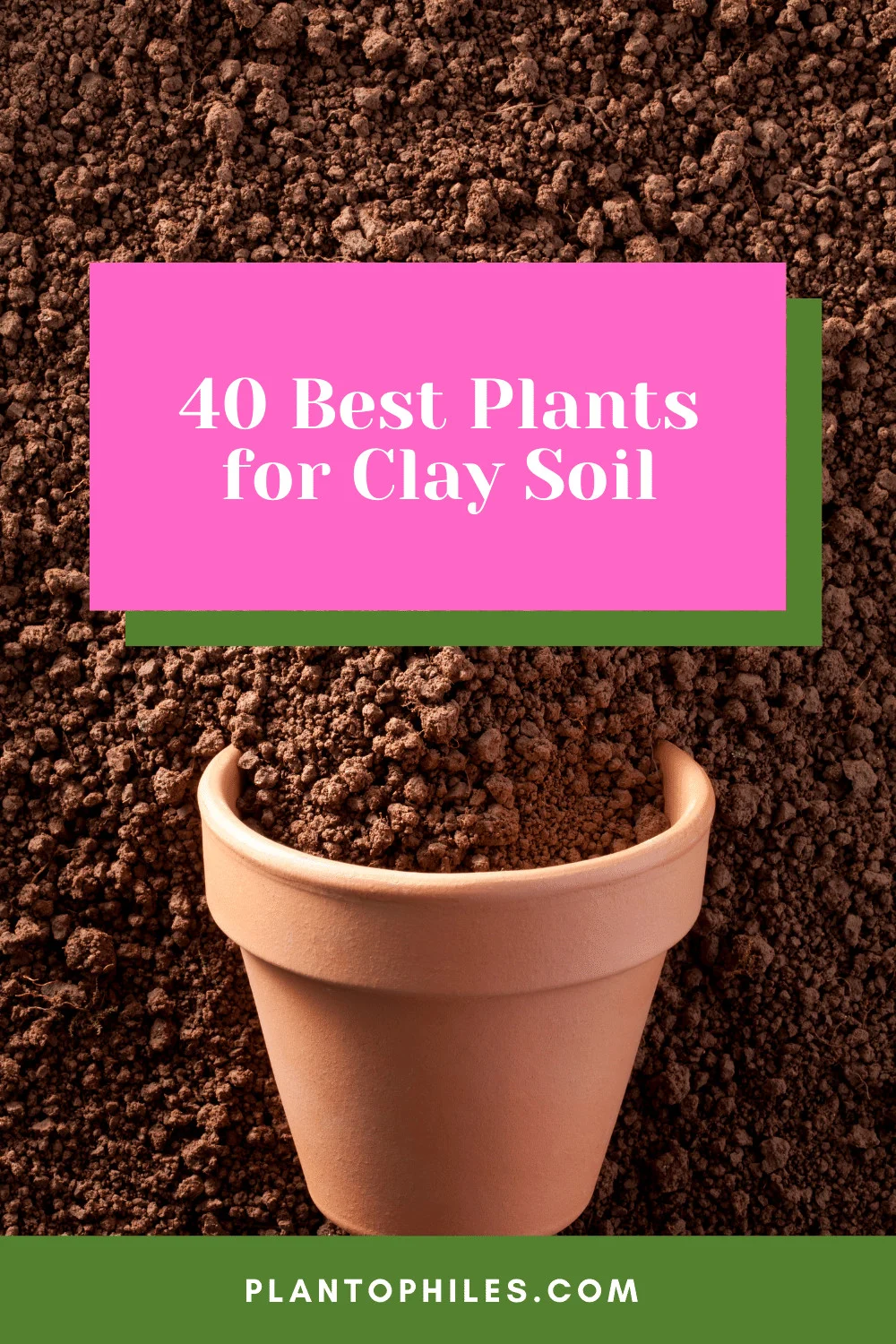
40 Best Plants for Clay Soil
Table of Contents
Best Plants for Clay Soil
1. Bearded Iris
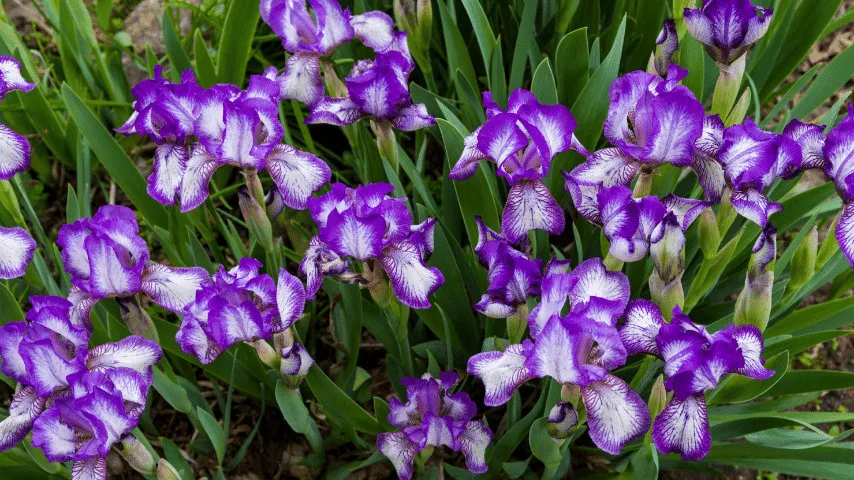
Bearded Iris should be planted in a spacious clayey soil bed setting to avoid overcrowding
Bearded Iris is commonly assumed as a simple Iris; however, Bearded Iris is different from the simple Iris.
Bearded Iris has a unique beard, making it different from beardless Iris.
It is better to grow Bearded Iris in a place where it enjoys uninterrupted sunlight throughout the day.
Moreover, Bearded Iris should be planted in a spacious bed setting to avoid overcrowding.
Scientific Name and Nomenclature
- Scientific name: Iris germanica
- Family: Iris family
- Temperature: 40-50°F (4-10°C) or above
- Fertilizer: 5-10-5 Low Nitrogen fertilizer
- pH: 6.5-88
- Lighting: At least 6 hrs. of sunlight
- Growth rate: Slow
- Humidity: 70-90%
2. Daylily
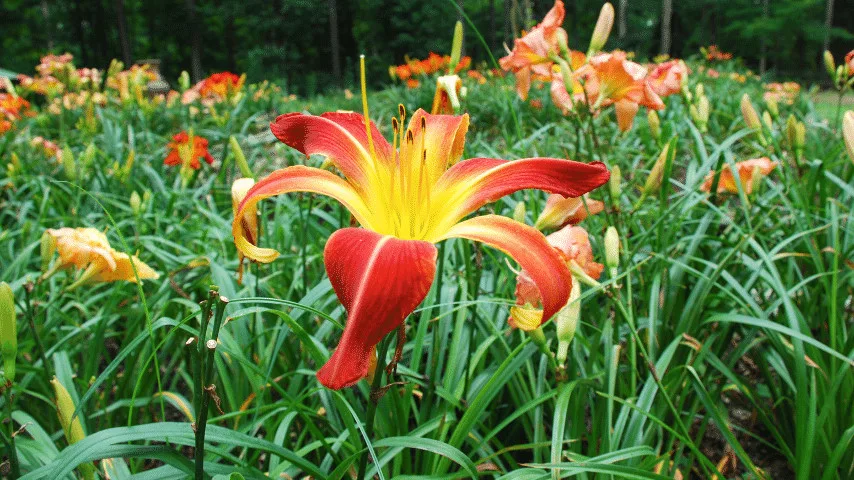
Gardeners love having attractive Daylily species in their clayey soil backyards and gardens
Daylily is a beautiful flowering plant that belongs to the family of Asphodelaceae.
Many hobbyists and gardeners love having attractive Daylily species in their backyards and gardens.
It’s true that Daylily thrives well in places where it gets 4-6 hours of exposure to bright sunlight.
As they grow, the petals of Daylily open up towards the sky, creating a beautiful landscape.
Scientific Name and Nomenclature
- Scientific name: Hemerocallis
- Family: Asphodelaceae
- Temperature: Low as -25°F (-32°C)
- Fertilizer: Slow-release fertilizers, seasoned manure, or compost
- pH: 6.0-6.5
- Lighting: At least 6 hrs. of sunlight
- Growth rate: Slow
- Humidity: 100% or maximum moisture content
3. Lilac
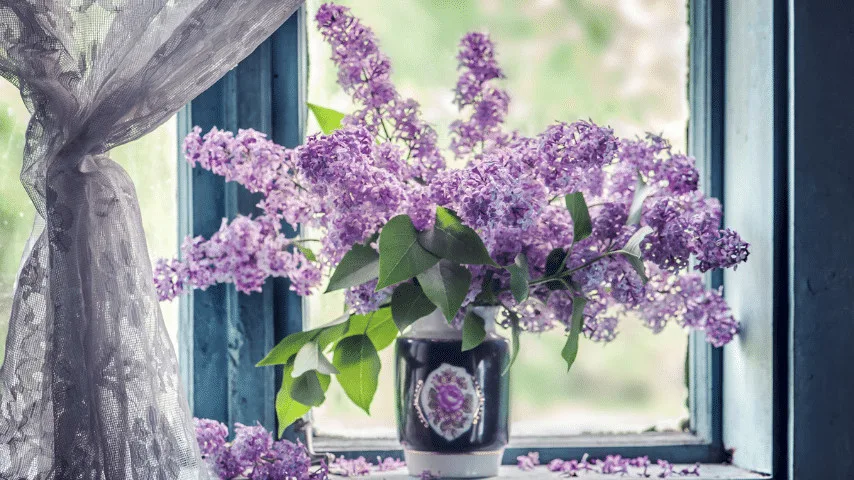
Lilac hobbyists prefer growing Lilac in winters in a clayey soil
Lilac belongs to the rich family of spring-flowering shrubs, representing youthfulness, tranquility, spirituality, and innocence.
The plant is named after its flower, which appears in blue and red colors as the plant get matures and blossoms.
Lilac is quite different from Lavender as Lilac grows with a pale purplish touch, whereas Lavender has a shade of pinkish tinge.
Lilac requires 6-8 hours of bright sunlight like many other attractive and blossoming plants.
Many gardeners and hobbyists prefer growing Lilac in winters, as Lilac has the distinctive ability to withstand cold temperatures and breezes.
Scientific Name and Nomenclature
- Scientific name: Syringa
- Family: Oleaceae
- Temperature: Can survive at a temperature of -40°F (-40°C)
- Fertilizer: 10-10-10 fertilizer to be applied only once before spring
- pH: 6.5-7.5
- Lighting: Full sun
- Growth rate: Slow
- Humidity:
4. Hosta
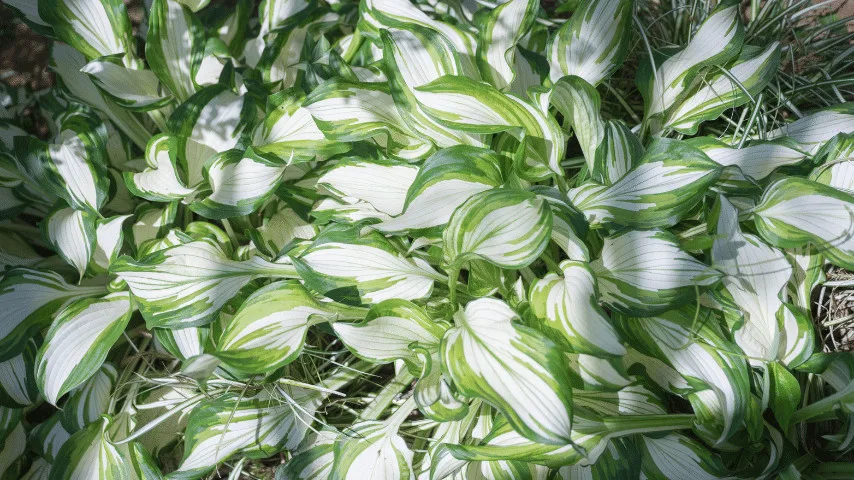
Hosta do well in clayey soil, as their roots require moist subgrades throughout the growing season
Hosta or Plantain Lily is among the favorite perennials of many gardeners and hobbyists as they have the ability to thrive up to 3-4 growing seasons.
With every passing season, Hosta grows bigger and greener. However, their foliage might not be appealing as previously, but they do well if kept in shaded areas.
Hostas do well in clayey soil, as their roots require moist subgrades throughout the growing season.
Scientific Name and Nomenclature
- Scientific name: Hosta
- Family: Asparagus
- Temperature: Can survive at a temperature of 33-41°F (0-5°C)
- Fertilizer: 10-10-10 fertilizers in the spring season
- pH: 6.5-7.5
- Lighting: Light sun to full shade
- Growth rate: Slow
- Humidity: 60-70%
5. Weigela
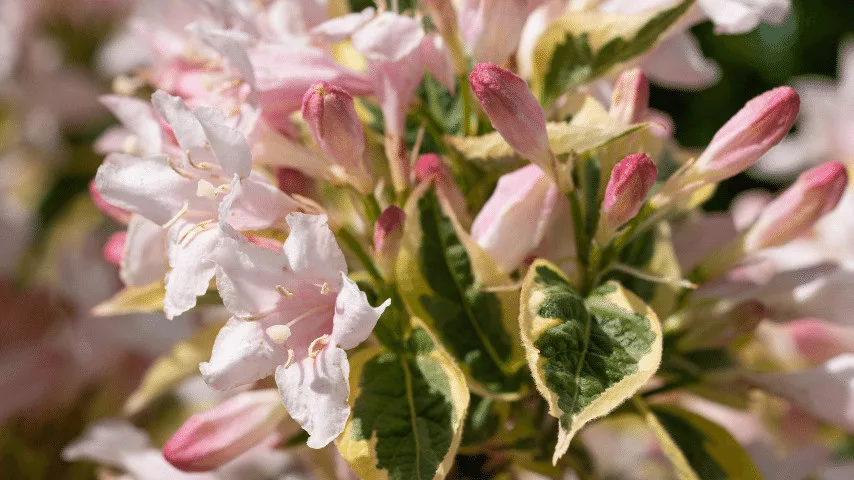
Weigela thrives well in clay and well-drained soils, as it’s a deciduous shrub
Weigela is suitable for areas where they can receive ample sunlight throughout the day. Weigela belongs to the shrubs family,
having little maintenance needs after the frost season. Weigela is adjustable to various climatic and hardiness zones and is capable of growing up to 4-10 feet.
Weigela thrives well in clay and well-drained soils, as it’s a deciduous shrub.
Scientific Name and Nomenclature
- Scientific name: Weigela
- Family: Honeysuckle
- Temperature: -25- -30°F (-32- -34°C) average minimum temperature
- Fertilizer: Slow release 10-10-10 balanced fertilizer
- pH: 5.5-7.5
- Lighting: 8-10 hrs. of sunlight or dappled shade
- Growth rate: Slow
- Humidity: Minimum 60%
6. Black Eyed Susan
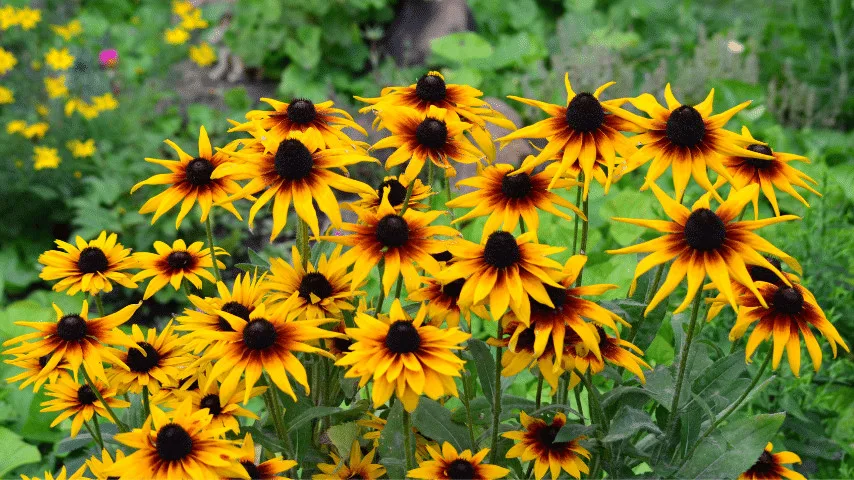
Black Eyed Susan best to grow in clay soil subgrades
Black Eyed Susan belongs to the family of Asteraceae and is quite famous for its brown circular daisy head in black.
Black Eyed Susan can be planted in damaged or reclaimed areas, irrespective of soil type and conditions.
However, it’s best to grow Black Eyed Susan in clay soil subgrades.
Scientific Name and Nomenclature
- Scientific name: Rudbeckia hirta
- Family: Daisy’s family
- Temperature: Around 70°F (16°C)
- Fertilizer: Granular general-purpose fertilizer
- pH: 6.8
- Lighting: Full sunshine to partial sun
- Growth rate: Fast
- Humidity: 55-75%
7. Coneflower
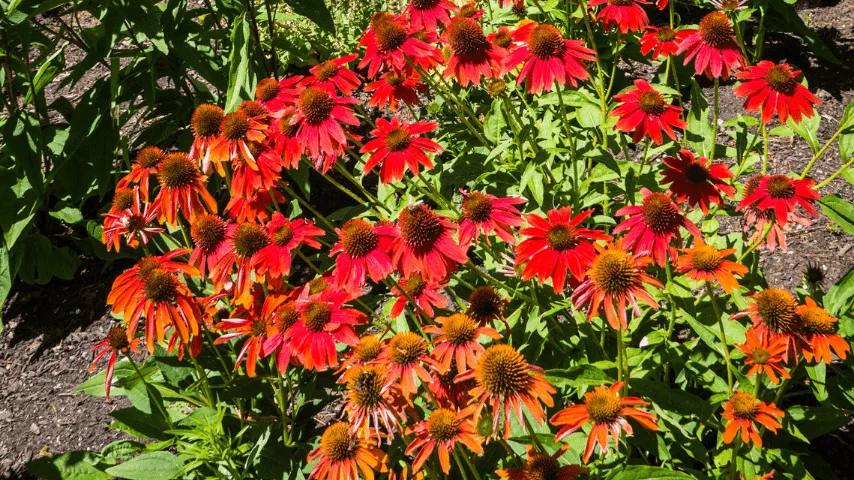
Coneflower growing in clayey soil, you have to look after its drainage discharge rate
Coneflowers are among the blooming perennials which are drought resistant in nature.
Coneflowers are grown by many amateur gardeners and hobbyists who love to have a blooming garden throughout the year.
Coneflowers can adjust with heat and variable soil types, making themselves easy to maintain and grow.
While growing in clayey soil, you have to look after its drainage discharge rate.
Scientific Name and Nomenclature
- Scientific name: Echinacea
- Family: Daisy
- Temperature: Around 65-68°F (18-20°C)
- Fertilizer: Applying 6-4-5 Happy Frog All-Purpose fertilizer is recommended
- pH: 6.5-7.2
- Lighting: 6-8 hrs. of sunlight or dappled shade
- Growth rate: Slow
- Humidity: High humidity, around 95%
8. Potentilla
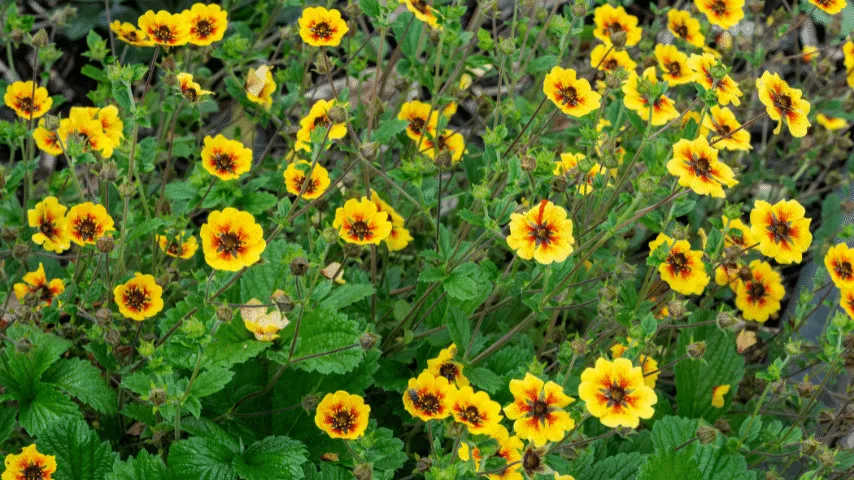
Potentilla prefers clayey soil types having a pH value of around 5-7
Potentilla loves staying in either full sun or partial shade depending on the space and garden type.
Potentilla also belongs to the deciduous shrubs family, having wild small leafy bushes with attractive flowers which appear as the blooming season arrives.
Potentilla prefers soil types having a pH value of around 5-7.
Scientific Name and Nomenclature
- Scientific name: Potentilla
- Family: Cinquefoils
- Temperature: At least -30°F (-34.4°C)
- Fertilizer: All-purpose fertilizer would suffice
- pH: 5-7
- Lighting: Minimum 6hrs. of direct sunlight
- Growth rate: Slow
- Humidity: Moderate
9. Bee Balm
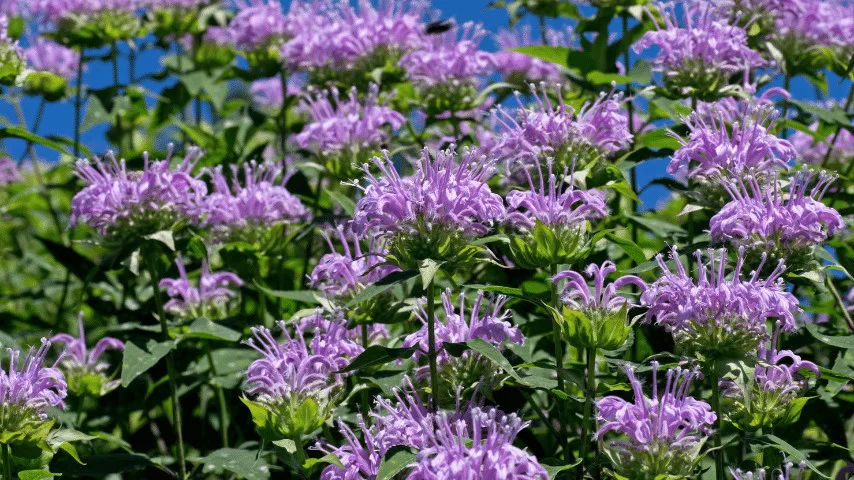
Bee Balm popular among hobbyists who prefer having colorful and attractive clayey soil garden spaces
Bee Balm is the natives of the North American region, found in dense woodlands across the country.
Bee Balm is among the few members of the Mints family that adds beauty to any garden.
The blossoming nature of Bee Balm makes them quite popular among hobbyists who prefer having colorful and attractive garden spaces.
Scientific Name and Nomenclature
- Scientific name: Pimpinella Monarda
- Family: Mints
- Temperature: 60-70°F (16-21°C)
- Fertilizer: 10-10-10 fertilizer is ideal
- pH: 6.0-6.7
- Lighting: Full sun to partial shade
- Growth rate: Medium
- Humidity: 40-100%
10. Lantana
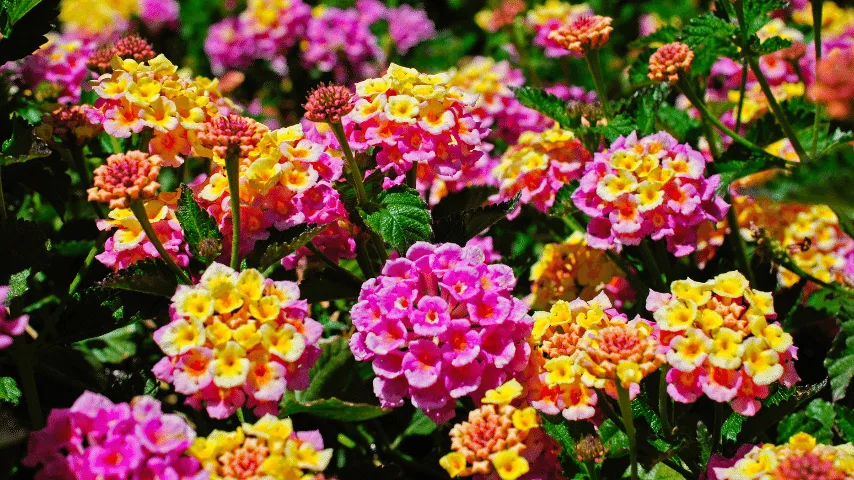
Lantana famous for their carefree nature as they require minimum or no maintenance except seasonal fertilizing in a clayey soil
Lantana is a perennial flower belonging to the family of Verbena. Their broadleaf variety gets pretty attractive and colorful as the blossoming season approaches.
Lantanas are famous for their carefree nature as they require minimum or no maintenance except seasonal fertilizing.
Scientific Name and Nomenclature
- Scientific name: Lantana camara
- Family: Verbenas
- Temperature: 30-55°F (0-12°C) or even greater
- Fertilizer: 10-10-10 or 20-20-20 balanced fertilizer
- pH: 6.0-6.5
- Lighting: Full sun
- Growth rate: Medium
- Humidity: 10-25% optimum
11. Petunia
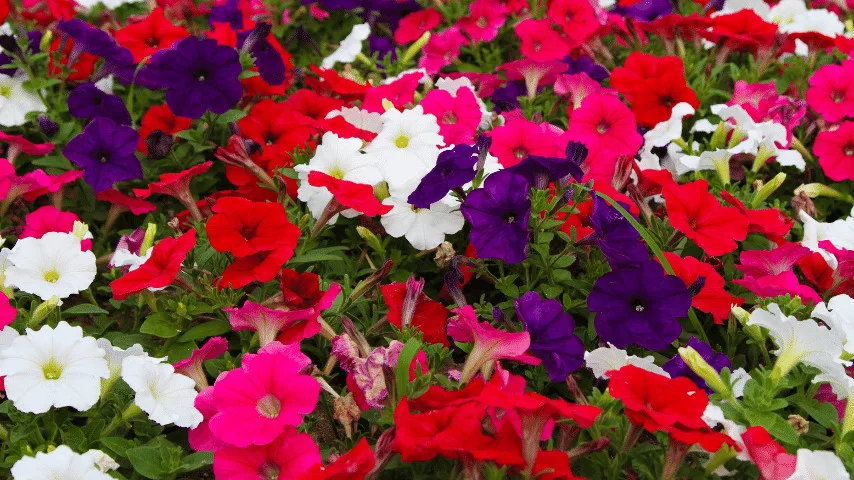
Petunia fit best for heavy clay soils with a pH between 6 to 6.5
Petunia is considered an annual plant in many regions, known mainly for its striking pinkish and white flowers.
During the blossom season, they are a treat for the eyes. If they are grown in warm regions, they might thrive up to 2-3 years.
For stable growth and nourishment, it’s recommended to water it once a week. Petunia fit best for heavy clay soils with a pH between 6 to 6.5
Scientific Name and Nomenclature
- Scientific name: Petunia
- Family: Nightshade
- Temperature: 55-80°F (12-26°C)
- Fertilizer: Balanced fertilizers (8-8-8, 10-10
- pH: 6.0-6.5
- Lighting: 5-6 hrs. of sunlight
- Growth rate: Fast
- Humidity: 50% Relative Humidity
12. Salvia
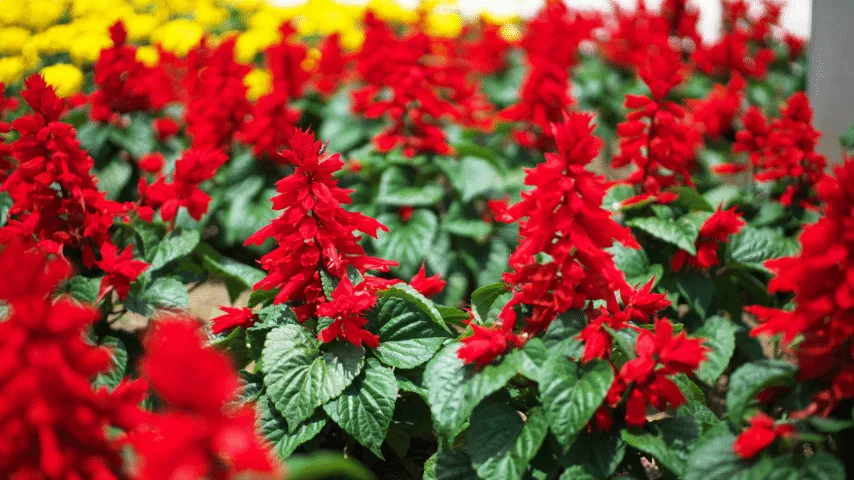
Salvia best fit your soil type if you have a clayey subgrade in your garden or backyard
Salvia appears during midsummers and is planted at the borders of a garden.
Salvia is planted during the spring season, as they grow throughout the moist weather and blossom just before summers.
The Salvia plant would best fit your soil type if you have a clayey subgrade in your garden or backyard.
Scientific Name and Nomenclature
- Scientific name: Sage
- Family: Mints
- Temperature: Above 32°F (0°C) is recommended
- Fertilizer: No fertilization required
- pH: 5.5-6.5
- Lighting: 6-8 hrs. of sunlight
- Growth rate: Fast
- Humidity: Above 50%
13. Goatsbeard
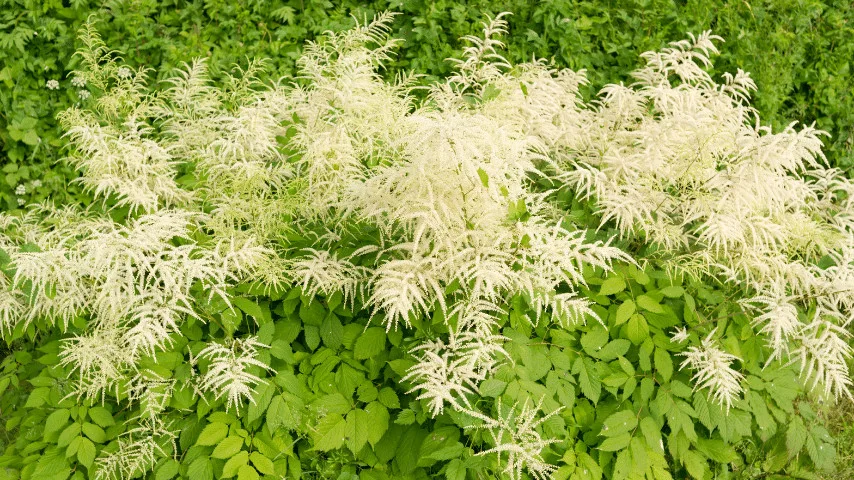
Goatsbeard rows well in clayey soils. However, you need to monitor its moisture level regularly
Goatsbeard (Aruncus dioicus) is commonly known as the bride’s feather as they resemble with the delicate white roses.
As the Goatsbeard grows over time, it produces off-white flowers, creating a mesmerizing look with green leaves in the backdrop.
Goatsbeard grows well in clayey soils. However, you need to monitor its moisture level regularly.
Scientific Name and Nomenclature
- Scientific name: Goatsbeard
- Family: Rose
- Temperature: Can survive upto -40°F (-40°C)
- Fertilizer: Add mixed compost to the soil every spring season
- pH: 6.0-8.0
- Lighting: Full sun
- Growth rate: Moderate
- Humidity: 30-50%
14. Sedum
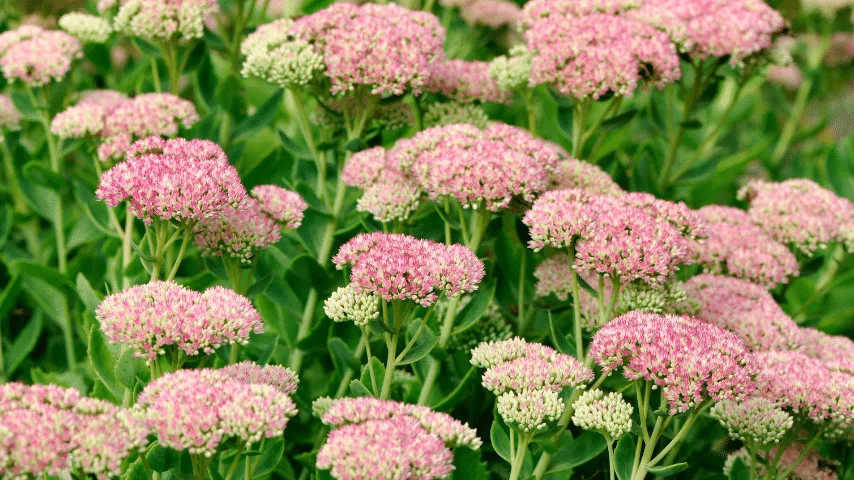
Sedum accepts clayey soils as long as it’s well-drained
Sedum belongs to the family of Crassulaceae, whose members are known as Stonecrops.
Sedums thrive well under full sun, but one can keep them in partially shaded spots, depending on the location and other environmental factors.
Sedum accepts clayey soils as long as it’s well-drained.
Scientific Name and Nomenclature
- Scientific name: Stonecrop
- Family: Crassulaceae
- Temperature: Can survive upto -20 – 30°F (-29 – -1.1°C)
- Fertilizer: All-purpose fertilizer with a balanced ratio of NPK
- pH: 5.95-6.9
- Lighting: 6 hrs. of sunlight daily is required
- Growth rate: Slow
- Humidity: 40-60%
15. Aronia
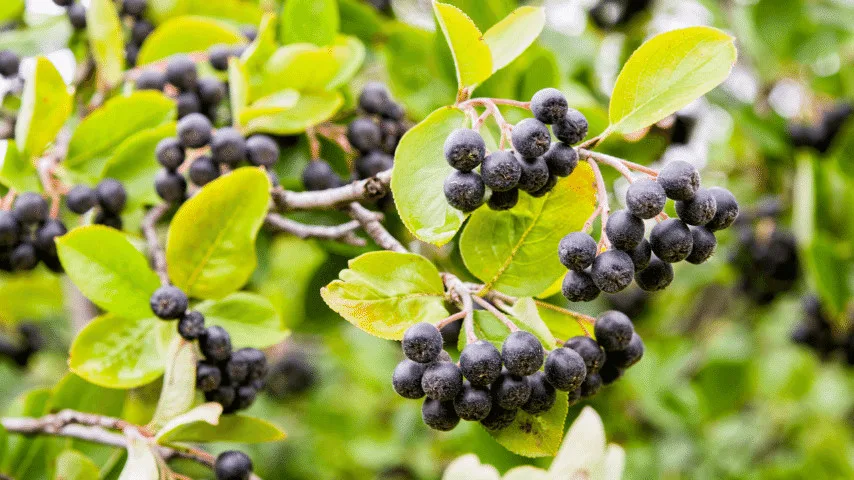
Aronia adapted to clay soil, making them easy to grow
Aronia is deciduous shrubs that produce chokeberries when grown in optimum conditions.
Aronia is widely found in the North American regions, includes Mexico and Canada.
They are adapted to clay soil, making them easy to grow in most states across the US.
You can plant Aronia in their backyard and enjoy chokeberries when ripened.
Scientific Name and Nomenclature
- Scientific name: Aronia melanocarpa
- Family: Rose
- Temperature: -13°F (-25°C)
- Fertilizer: Adding aged manure or peat moss to the soil would be sufficient
- pH: 6-6.5
- Lighting: Full sunlight
- Growth rate: Fast
- Humidity: Optimum moisture required
16. Rose of Sharon
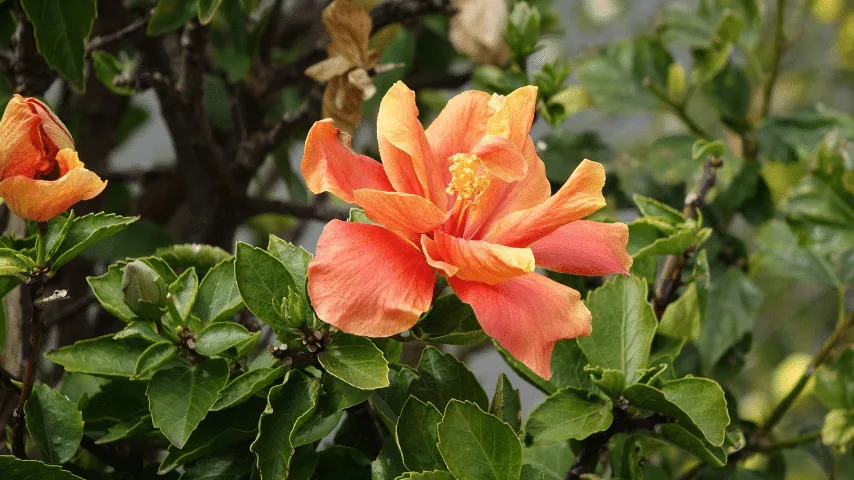
Rose of Sharon grows in poor soil type, a clayey soil would serve best
Growing Rose of Sharon is recommended to young hobbyists and amateur gardeners who aspire to see vibrant flowers in their nurseries next season.
As Rose of Sharon grows in poor soil type, a clayey soil would serve best to Rose of Sharon.
Their eye-catching vase-shaped structure is among the peculiar features of the flower.
Scientific Name and Nomenclature
- Scientific name: Hibiscus syriacus
- Family: Rose
- Temperature: 85-100°F (30-40°C)
- Fertilizer: Granular rose fertilizer would suffice
- pH: 7-8
- Lighting: At least 6 hrs. of sunlight daily
- Growth rate: Slow or moderate
- Humidity: 50-90%
17. Helenium
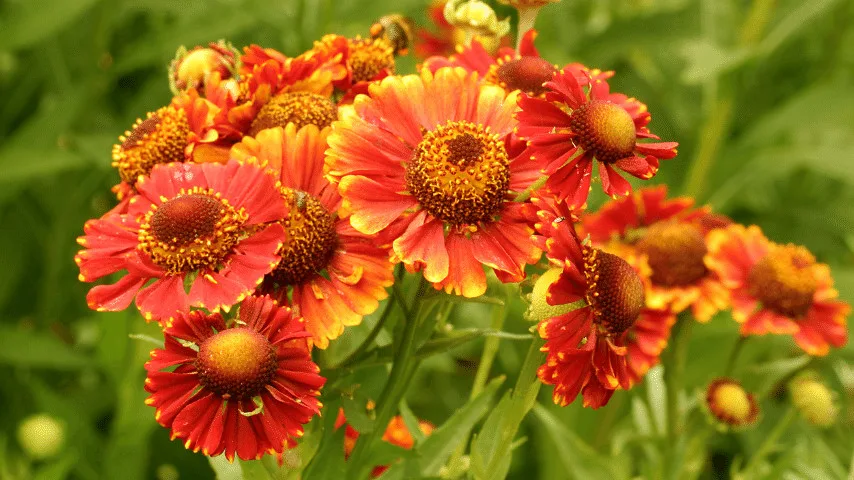
Helenium prefer growing in well-drained soils, including clay
Helenium is known for attracting butterflies after blossoming. They prefer growing in well-drained soils, including clay.
Helenium is quite similar to Coneflowers; however, a determined hobbyist or a gardener can identify the difference on careful observations.
Scientific Name and Nomenclature
- Scientific name: Helenium
- Family: Asteraceae
- Temperature: Around 70°F (21°C)
- Fertilizer: Balanced fertilizers during springs only
- pH: 5.5-7.0
- Lighting: Direct sunlight or afternoon shade
- Growth rate: Slow
- Humidity: Around 52%
18. Hardenbergia Violacea
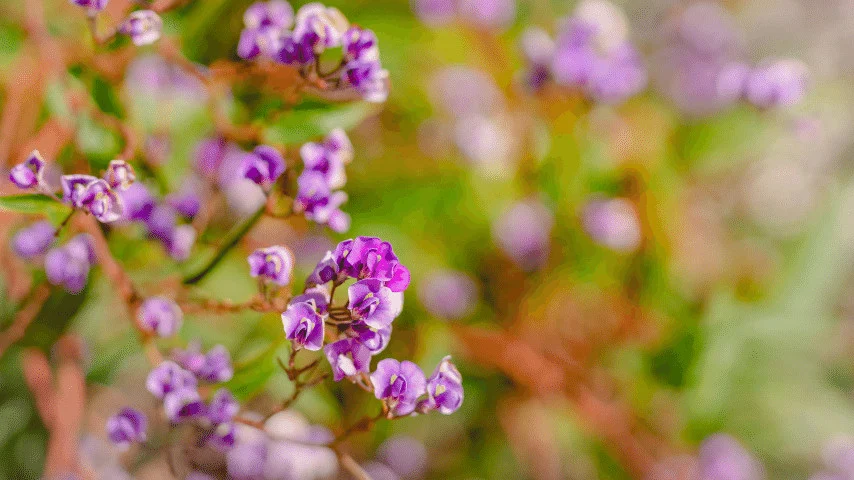
Hardenbergia Violacea best suits cultivators’ needs as they are habitual of growing in various soil types, including clay
Hardenbergia Violacea, commonly known as Happy Wanderer, best suits cultivators’ needs as they are habitual of growing in various soil types.
It produces alluring small flowers in a purplish shade, adding color to your garden or nursery.
Scientific Name and Nomenclature
- Scientific name: Hardenbergia violacea
- Family: Legumes
- Temperature: 55-65°F (13-18°C)
- Fertilizer: Phosphorus rich fertilizers are recommended
- pH: 5.5-6.0
- Lighting: Optimum sunlight depending upon weather
- Growth rate: Moderate
19. Indigofera Australis
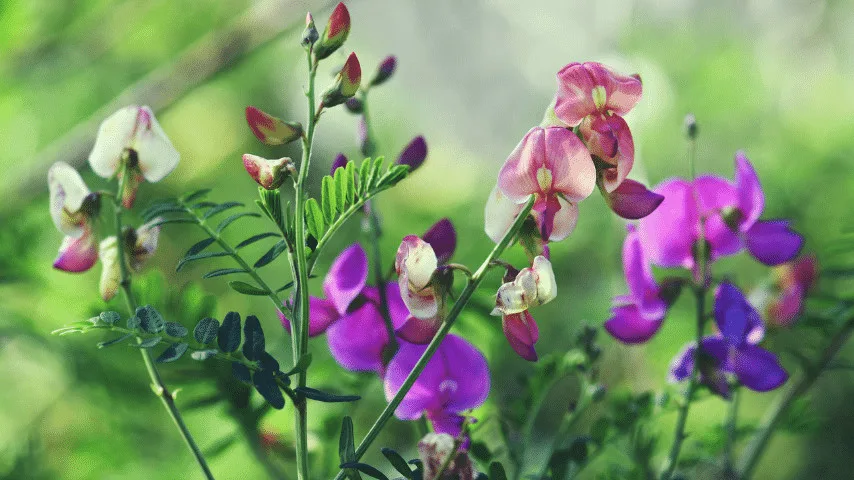
Indigofera Australis best to grow them in clay or well-drained soil, having optimum moisture content
Indigofera Australis thrives in fertile soil and a hot climate. It’s best to grow them in clay or well-drained soil, having optimum moisture content.
Indigofera Australis needs to be placed under full sunlight where it can receive the maximum amount of light during the day.
Outdoor gardens and nurseries are ideal spots for growing Indigofera Australis.
Scientific Name and Nomenclature
- Scientific name: Indigofera australis
- Family: Legumes
- Temperature: 64-71°F (18-22°C)
- Fertilizer: Little or no fertilizers required
- pH: 6.8-8
- Lighting: Full sunlight is best
- Growth rate: Moderate
20. Grevilla x Gaudichaudii
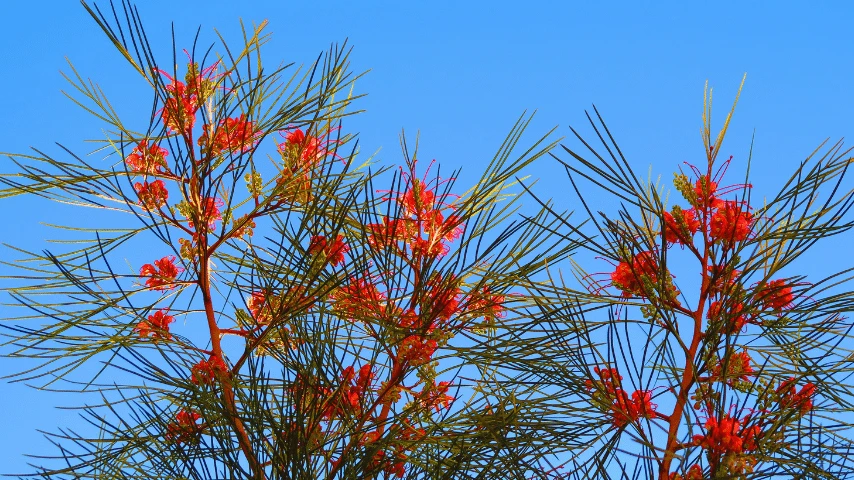
Grevilla x Gaudichaudii best for ground covers in outdoor clayey soil gardens and nurseries
Grevilla x Gaudichaudii is best for ground covers in outdoor gardens and nurseries.
They offer dense flowers and shrubs, adding beauty to the entire garden space.
They can grow a maximum of up to 1ft during their growing period without any maintenance or special care.
Scientific Name and Nomenclature
- Scientific name: Grevillea gaudichaudii
- Family: Proteaceae
- Temperature: 10°F (-12°C)
- Fertilizer: Applying 13-2-13 or 14-0-14 fertilizers after every 2 months is recommended
- pH: 6.8-7
- Lighting: Full sun
- Growth rate: Slow
Humidity: Damp condition is preferred
21. Phlox
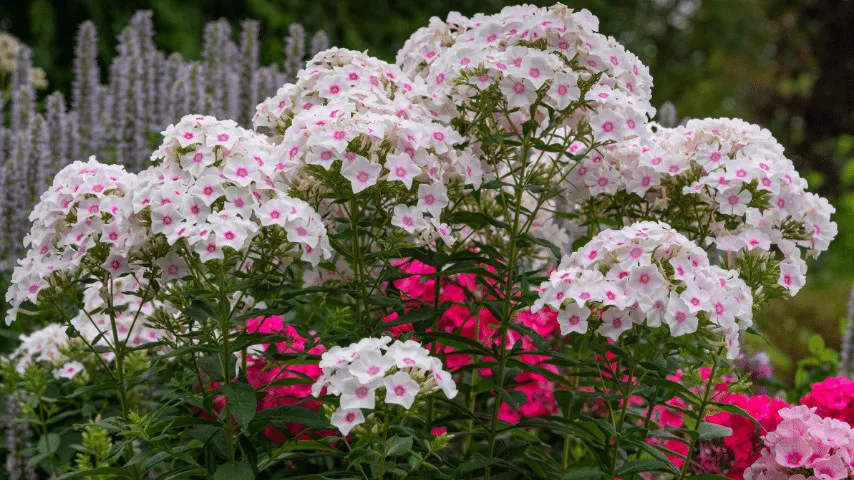
Phlox fit best as ground cover in any properties of soil, such as clay
Phlox are considered herbaceous plants which produce scented flowers during the summer period.
Phlox can be grown into tall perennials or alpine verities, depending on the breeding methods.
Phlox flowers fit best as ground cover in any properties of soil, such as clay.
If you have a clayey sub-base in your garden and you are looking for decent ground cover, then Phlox are the best plants for you.
Scientific Name and Nomenclature
- Scientific name: Phlox subulata
- Family: Phlox
- Temperature: Around 68-74°F (20-23°C)
- Fertilizer: Apply 10-10-10 balanced fertilizer or compost annually
- pH: 6.0-8.0
- Lighting: Full sun is ideal
- Growth rate: Slow
- Humidity: Around 90% Relative Humidity
22. Geranium
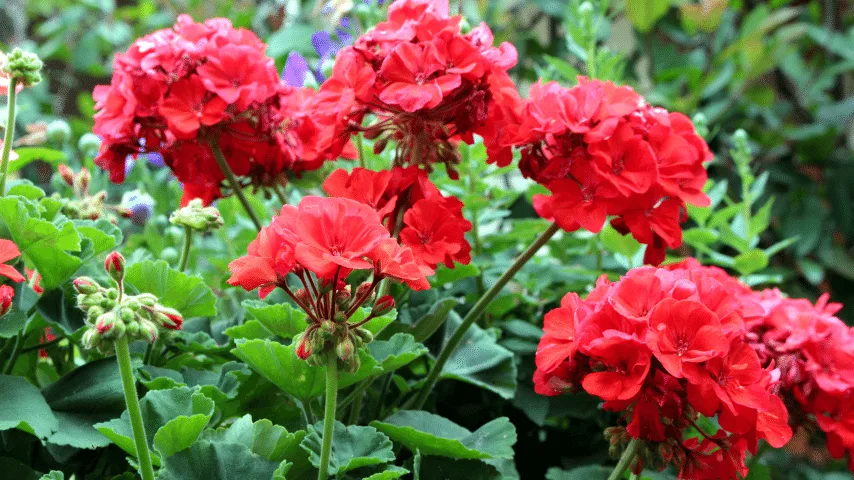
Geranium capable of growing in clay soil under different environmental conditions
Geraniums are the first choice of many gardeners and hobbyists as bedding plants.
Geraniums can’t grow tall; hence they fit best in the garden’s lowest levels.
They are commonly known as cranesbills, having widespread flower structures.
Geraniums flower has a white purplish or light pinkish shade that only blossoms during the spring season.
They are also capable of growing in clay soil in various environmental conditions.
Scientific Name and Nomenclature
- Scientific name: Pelargonium
- Family: Geraniaceae
- Temperature: 60-75°F (18-23°C)
- Fertilizer: 15-15-15, 15-16,17 or 20-10-20 fertilizers are recommended
- pH: 6.0-6.5
- Lighting: 12 hrs. of direct sunlight
- Growth rate: Moderate
- Humidity: 40-100%
23. Hydrangea
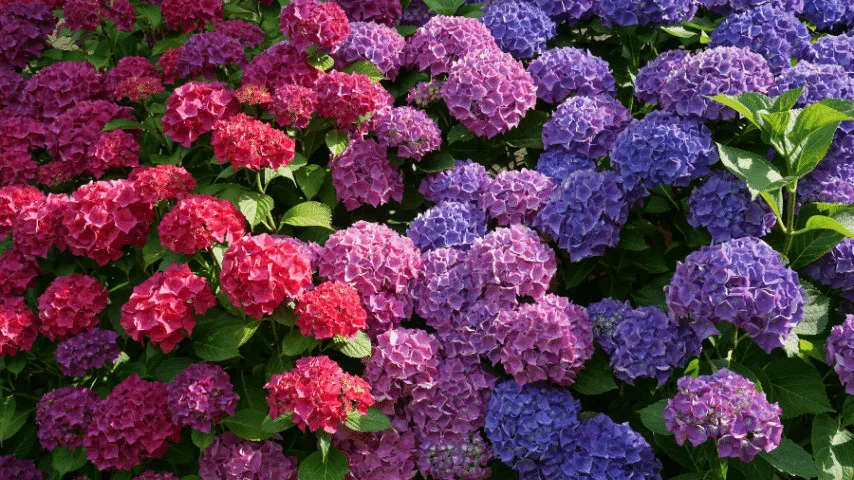
Hydrangea grows well in clay soil, having great fertility and natural content reserves
Hydrangea plants are picked by hobbyists who prefer adding attractive shaped flowers to their outdoor gardens and nurseries.
Hydrangea globe-shaped flowers stay blossomed during summers and spring. During extreme winters, it’s recommended to cover them with a layer of mulch.
Hydrangea grows well in clay soil, having great fertility and natural content reserves.
Scientific Name and Nomenclature
- Scientific name: Hydrangea
- Family: Hydrangeaceae
- Temperature: 45-60°F (7-15°C)
- Fertilizer: 10-10-10 or 12-4-8 NPK fertilizer are recommended
- pH: 6.0-6.2
- Lighting: Partial sun
- Growth rate: Moderate
- Humidity: 30-80%
24. Heuchera
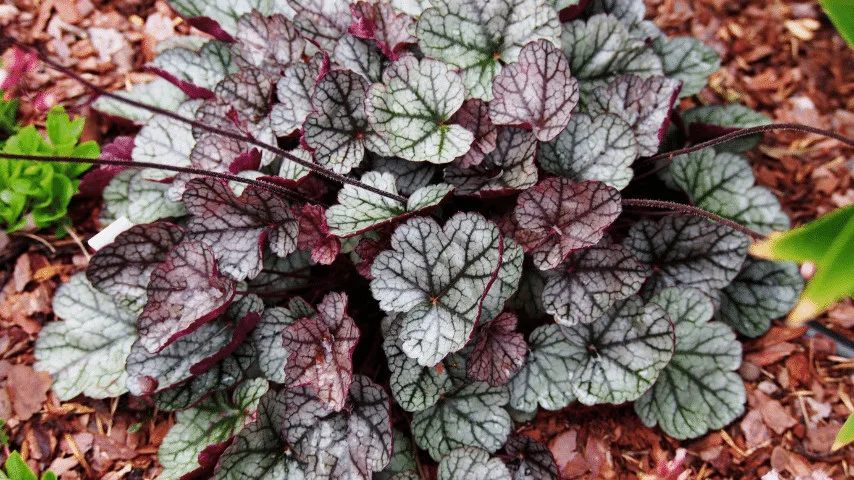
Heuchera can always plant in clay soil, which has sufficient drainage to suit its requirements
Heuchera, also known as the Coral Bells, is considered an attractive perennial flower, having bell-like flowers and alluring foliage.
Depending on their growth and other environmental factors, they can be kept in various shades.
You can always plant Heuchera in clay soil, which has sufficient drainage to suit Heuchera’s requirements.
Scientific Name and Nomenclature
- Scientific name: Heuchera
- Family: Saxifrages
- Temperature: 59-64°F (15-18°C)
- Fertilizer: A half-inch of compost to be applied during spring
- pH: 6.0-7.0
- Lighting: Full to partial sunlight
- Growth rate: Moderate
- Humidity: Around 95%
25. Big Bluestem
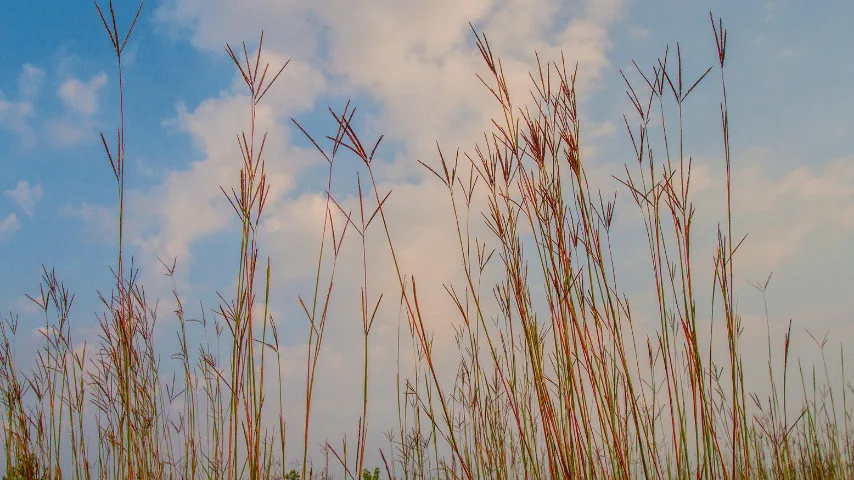
Big Bluestem few types of tall grasses that can grow in clay soil
Big Bluestem is among the few types of tall grasses that can grow in clay soil. Once these large grasses get developed, they form prairie sod.
Big Bluestem attracts cows for grazing; however, overgrazing can lead to temporary or permanent damage to the plant. They can grow as tall as 8 ft creating an attractive space.
Scientific Name and Nomenclature
- Scientific name: Andropogon gerardii
- Family: Grasses
- Temperature: Above 80-90°F (26-32°C)
- Fertilizer: 2:1:1 NPK fertilizer to be applied per acre
- pH: 4.8-6.9
- Lighting: Full exposure to the sun
- Growth rate: Fast
- Humidity: Above 50%
26. Blazing Star
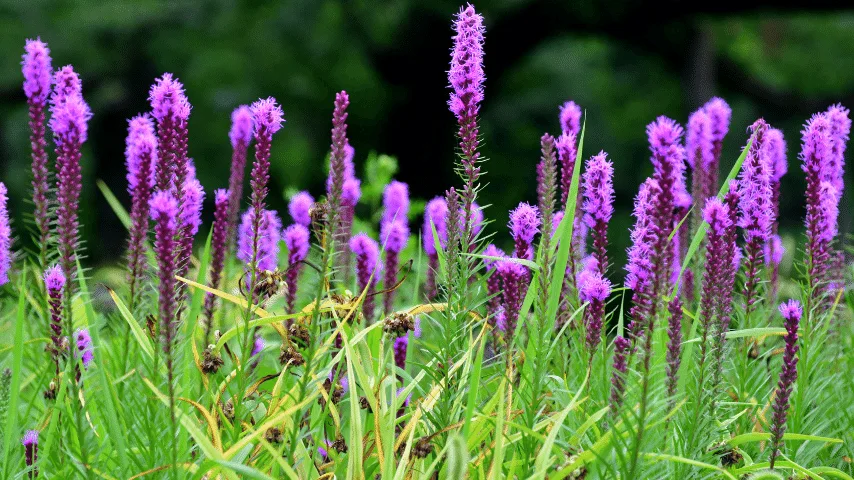
Blazing Star accepts fertile clayey soil and thrives well in it
Blazing Star is known as gayfeather and prairie star due to its striking appearance.
While growing Blazing Star, you should always monitor its root system, which develops after weeks of the plantation.
Hence, it’s best to provide it with fresh water on a daily basis.
Moreover, they require little care and maintenance as they blossom from top to bottom.
It’s best to separate its clumps in order to avoid overstuffing. Blazing Star accepts fertile clayey soil and thrives well in it.
Scientific Name and Nomenclature
- Scientific name: Liatris
- Family: Daisy
- Temperature: Around 60-75°F (18-21°C)
- Fertilizer: Apply balanced flower fertilizer once a year
- pH: 5.5-7.5
- Lighting: Full exposure to the sun
- Growth rate: Moderate
- Humidity: Around 30% Relative Humidity
27. Butterfly Weed
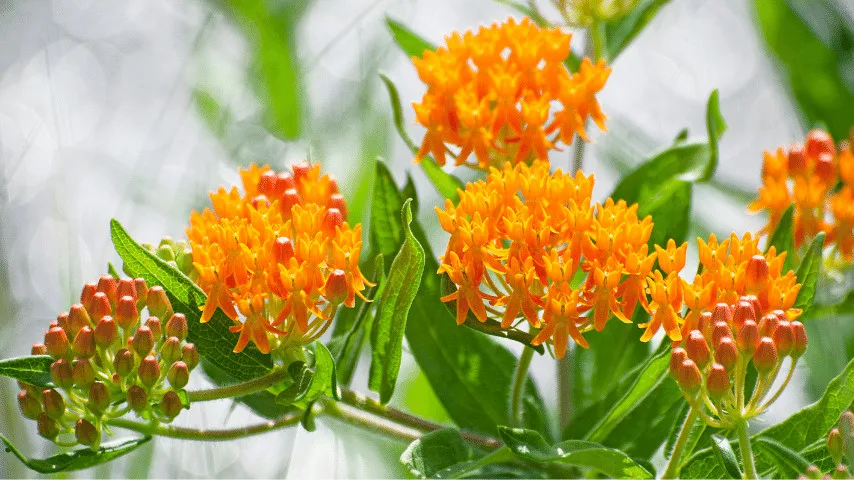
Butterfly Weed gets adapted to any properties of soil, such as clay
As their name suggests, they attract butterflies throughout the day. Their lush green foliage covered with yellow pollen grains is the most appealing feature of them.
Most towns of Michigan have a large volume of Butterfly Weeds. Butterfly Weed gets adapted to any properties of soil, such as clay
Scientific Name and Nomenclature
- Scientific name: Asclepias tuberosa
- Family: Dogbanes
- Temperature: Around 60-75°F (18-21°C)
- Fertilizer: No fertilizers required
- pH: 6.0-7.0
- Lighting: Full sun
- Growth rate: Medium
28. Canadian Wild Rye
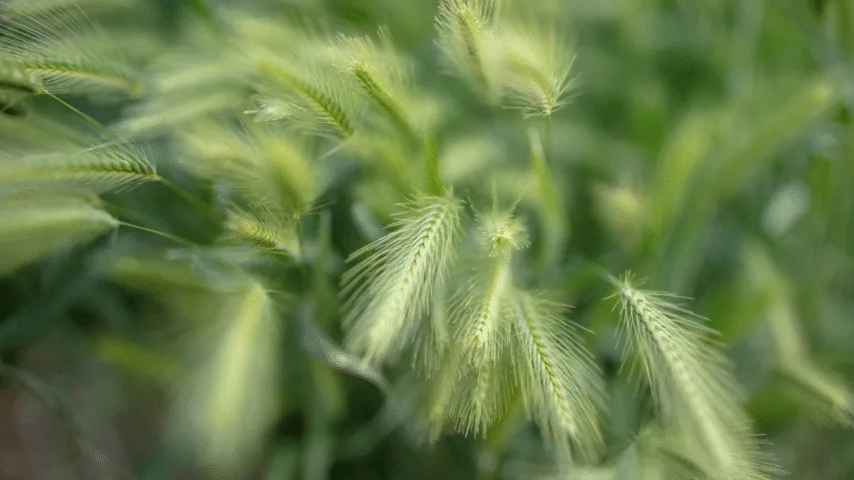
Canadian Wild Rye versatile grass type requiring no maintenance or special treatment, including clayey soil
Canadian Wild Rye or Elymus Canadensis is a versatile grass type requiring no maintenance or special treatment.
The cool-season grass can rise tall up to 3-5 feet depending on the stems and leaves.
If you have traveled to Canada, you might have observed that the entire southern half of Canada has Elymus Canadensis abundantly.
Scientific Name and Nomenclature
- Scientific name: Elymus canadensis
- Family: Grasses
- Temperature: Around 70°F (21°C)
- Fertilizer: No fertilizers required
- pH: 5.0-7.0
- Lighting: Full sun exposure is ideal
- Growth rate: Fast
- Humidity: 15-40%
29. Compass Plant
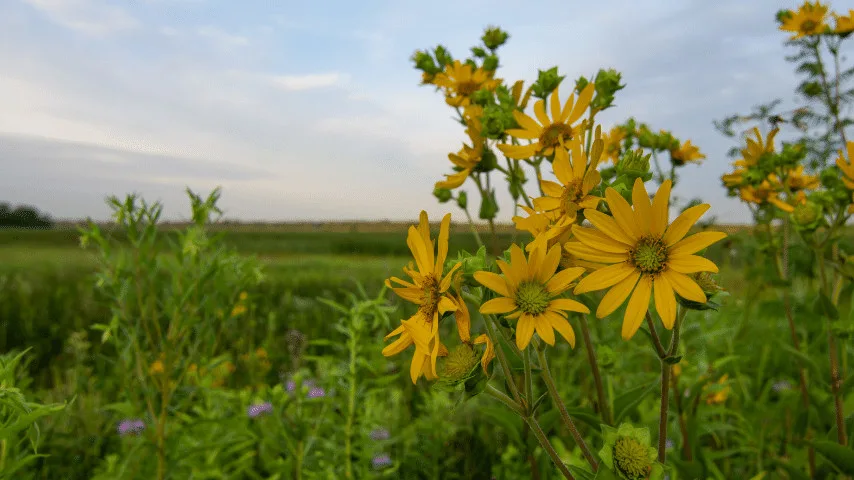
Compass Plant thrives well in heavy soils, such as clay, that offer ample nutrients and fertility
Compass Plant is among the very few sunflowers that can grow tall in the north-south direction.
It has a yellowish rosinweed stem with an attractive flower head that attracts insects and bees throughout the day.
Compass Plant thrives well in heavy soils, such as clay, that offer ample nutrients and fertility.
Scientific Name and Nomenclature
- Scientific name: Silphium laciniatum
- Family: Daisy
- Temperature: Around 70-95°F (21-35°C)
- Fertilizer: No fertilizers required
- pH: 6.5-7.5
- Lighting: Full sunlight or partial sun
- Growth rate: Slow
- Humidity: 70-100%
30. Cup Plant
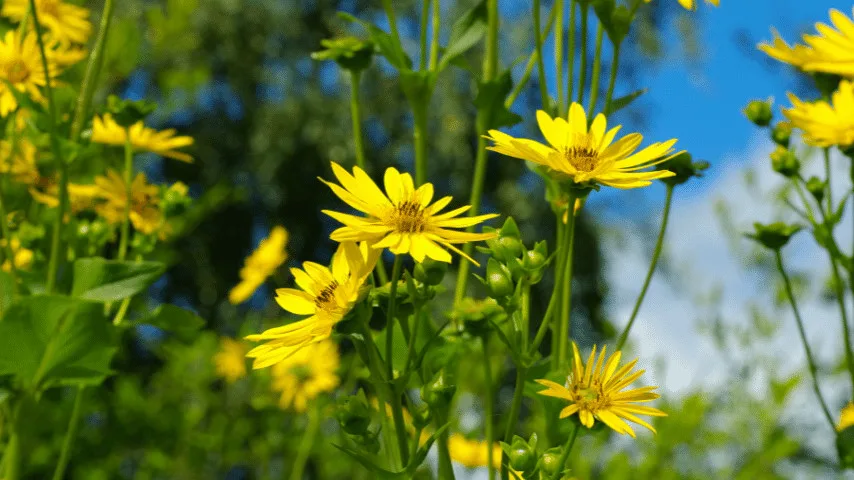
Cup Plant thrives well in moist or wet soils like clay
As its name suggests, Cup Plant is grown in pots and containers, which can be placed outdoors and on indoor racks.
Cup Plant thrives well in moist or wet soils like clay.
When it starts blooming, it produces bright yellow flowers that are a store for nectar for honeybees and other flowering insects.
Scientific Name and Nomenclature
- Scientific name: Silphium laciniatum
- Family: Daisy
- Temperature: Around 70-°F (21-35°C)
- Fertilizer: No commercial fertilizers are required
- pH: 6.5-7.8
- Lighting: Full sun exposure
- Growth rate: Slow
- Humidity: 15-95%
31. Drooping Coneflower
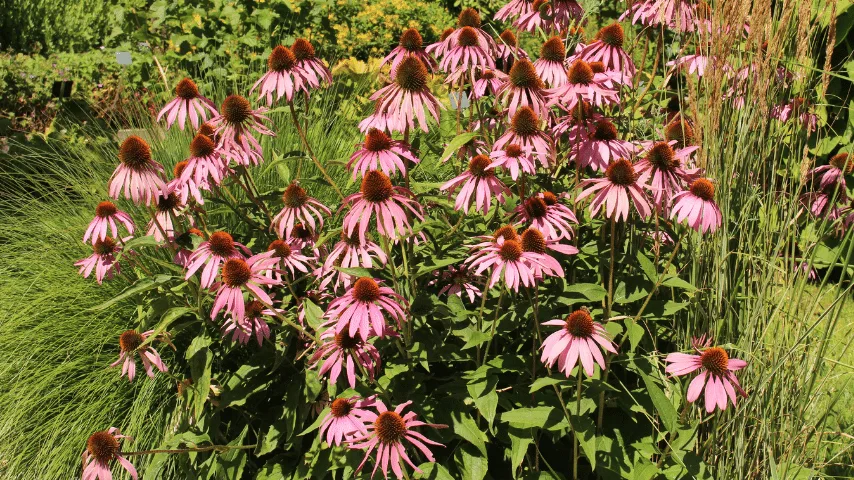
Drooping Coneflower raising them in clayey soil, you should monitor the soil’s moisture content
Drooping Coneflower appears in a spider-like structure once the flowers start to bloom in early summers.
Drooping Coneflower grows in whitish and pale pink colors, adding vibrant colors to your garden and nurseries.
They develop a strong root system and grow up to 3ft in height.
While raising them in clayey soil, you should monitor the soil’s moisture content, as too much moisture can lead to wilting in flower buds.
Scientific Name and Nomenclature
- Scientific name: Echinacea pallida
- Family: Daisy
- Temperature: At least 65°F (18°C)
- Fertilizer: Applying seasoned manure or compost would be ideal
- pH: 6.8-7.2
- Lighting: 6 hrs. of sunlight is recommended
- Growth rate: Moderate
- Humidity: 15-95%
32. Indian Grass
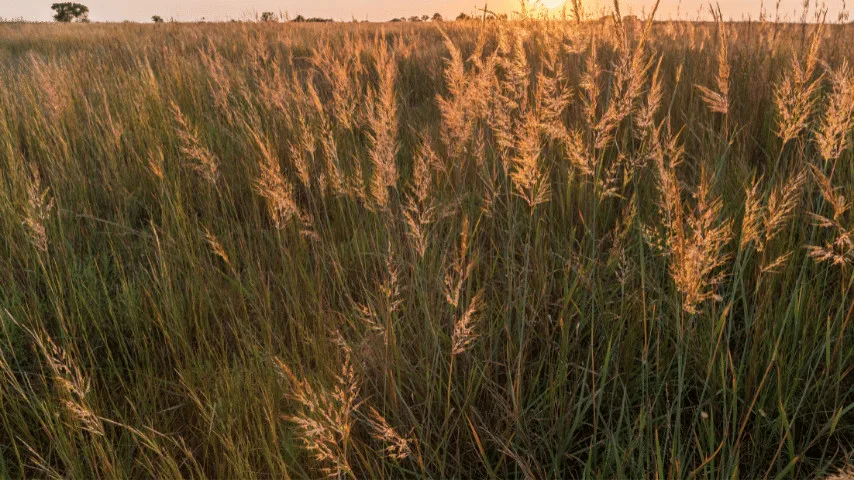
Indian Grass grow well in clay and sandy soils without any special care or maintenance
Most gardeners working in huge fields and open spaces love having Indian Grass in the entire area.
Indian Grass has the ability to grow up to 8ft rapidly without any special care or maintenance.
Indian Grass can be located in most areas of Texas and Iowa. Depending on several other environmental factors, they grow well in clay and sandy soils.
Scientific Name and Nomenclature
- Scientific name: Sorghastrum nutans
- Family: family Poaceae
- Temperature: Above 50°F (10°C)
- Fertilizer: Phosphorus based fertilizers are best
- pH: 4.8-8.0
- Lighting: From full sun to moderate shade
- Growth rate: Moderate
- Humidity: Over 50%
33. New York Ironweed
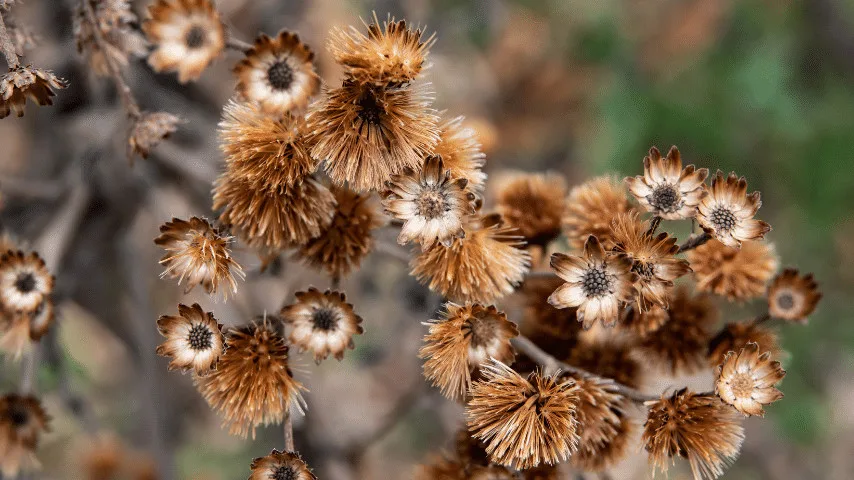
New York Ironweed capable of thriving in clay soils with moisture
New York Ironweed is also classified as a perennial plant, with a tall height of 5-8ft.
Ironweed offers a vibrant attraction to typical gardens and nurseries. Its deadhead blossoms contain seeds for pollination, which are carried away by pollinators.
Ironweed is capable of thriving in clay soils with moisture.
Scientific Name and Nomenclature
- Scientific name: Vernonia noveboracensis
- Family: Daisy
- Temperature: Above 70°F (21°C)
- Fertilizer: Water soluble fertilizers
- pH: 5.0-6.5
- Lighting: Full sunlight to partial sunlight
- Growth rate: Moderate
- Humidity: Moist conditions are ideal
34. Arkansas Blue Star
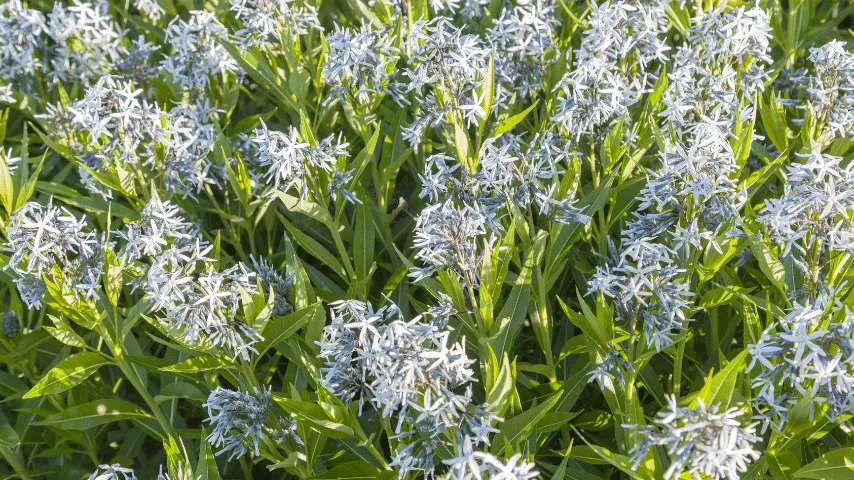
Arkansas Blue Star plant on clayey soil under optimum conditions for desired growth during all seasons
Arkansas Blue Star is native to Arkansas and its surrounding areas.
It is sometimes referred to as a perennial plant, having a blooming period during the spring season.
You could plant Blue Star under optimum conditions for desired growth during all seasons.
If grown in optimum conditions, it can spread about 50 inches in width.
Scientific Name and Nomenclature
- Scientific name: Amsonia Hubrichtii
- Family: Apocynaceae
- Temperature: Hot and humid climate is ideal
- Fertilizer: Water soluble fertilizers
- pH: 6.2-7.0
- Lighting: Full sunlight to partial sunlight
- Growth rate: Moderate
- Humidity: 40-80%
35. Sweet Flag
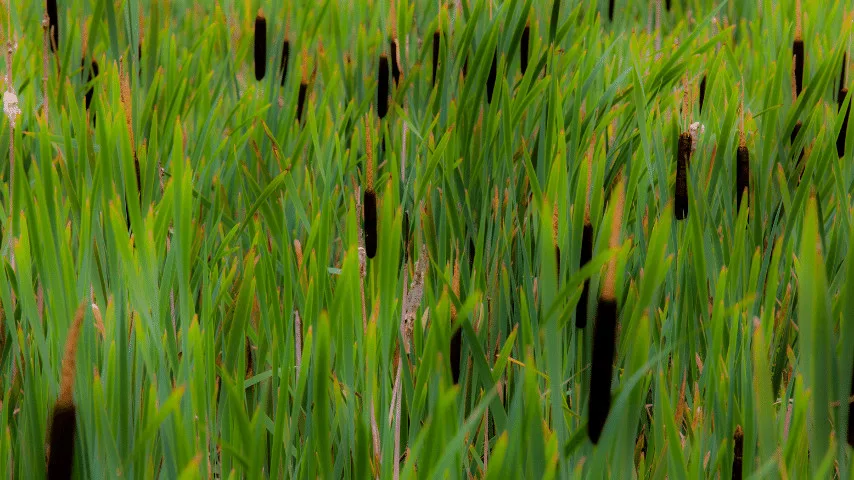
Sweet Flag growing must have clayey soil with wet conditions and a cool climate
Sweet Flag, also known as Acorus Calamus, is an herbal flowering plant used in the making of medicines.
Sweet Flag is quite common across Canada and a few other North American regions.
For growing Sweet Flags, you must have wet conditions and a cool climate. Sweet Flag doesn’t require much maintenance as it’s just like other grasses.
Scientific Name and Nomenclature
- Scientific name: Acorus calamus
- Family: Acoraceae
- Temperature: 39°F (4°C)
- Fertilizer: Applying compost with Nitrogen and Phosphorus is ideal
- pH: 5.0-7.0
- Lighting: Full sun to partial shade light
- Growth rate: Moderate
- Humidity: Optimum moisture required at the time of irrigation
36. Malus (crab apple)
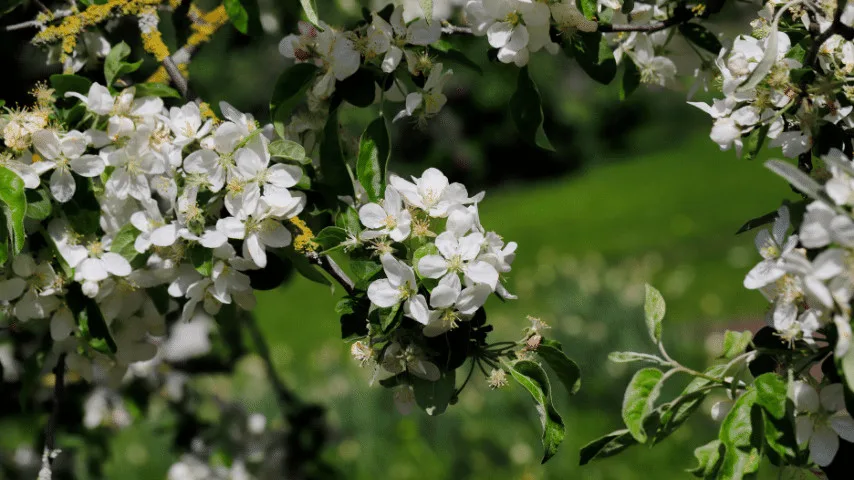
Malus (crab apple) thrive well in clayey soils with ample moisture and produce white blossoms
Malus or crab apple is known for producing fruit in the autumn season and blossoming flowers during the spring season.
They thrive well in clayey soils with ample moisture and produce white blossoms.
Scientific Name and Nomenclature
- Scientific name: Malus
- Family: Apples
- Temperature: Minimum 53-80°F (12-27°C)
- Fertilizer: 10-10-10 fertilizer would be ideal
- pH: 5.0-8.0
- Lighting: Full sun
- Growth rate: Moderate
- Humidity: 70-90%
37. Viburnum Tinus
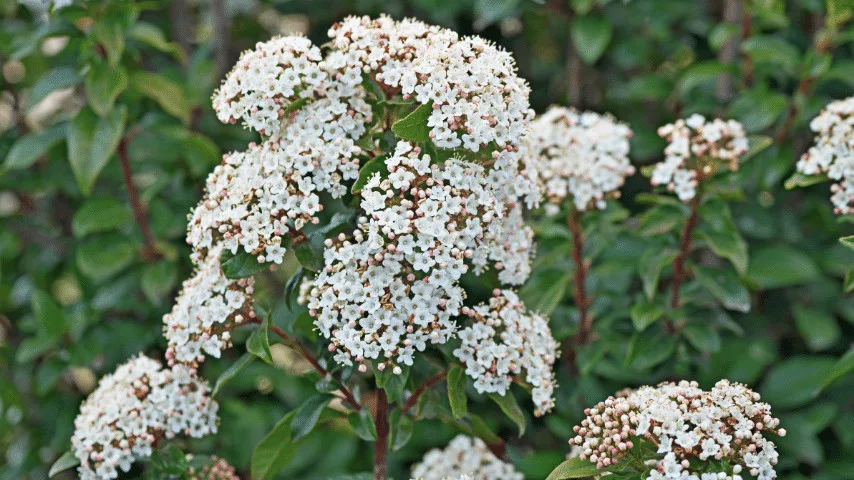
Viburnum Tinus offering eye-catching bushy green shrubs in clayey soil gardens and outdoor fields
Viburnum Tinus comes under the category of shrubs, offering eye-catching bushy green shrubs in gardens and outdoor fields.
As the winter ends, its flowers blossom, creating an attractive display of vibrant backdrops.
Scientific Name and Nomenclature
- Scientific name: Viburnum
- Family: Adoxaceae
- Temperature: Over 10-15°F (-12- -9°C)
- Fertilizer: Applying compost, fish emulsion, or rotted manure is recommended
- pH: 5.5-6.5
- Lighting: Full sun to partial shade
- Growth rate: Slow
- Humidity: 40-60%
38. Alchemilla Mollis
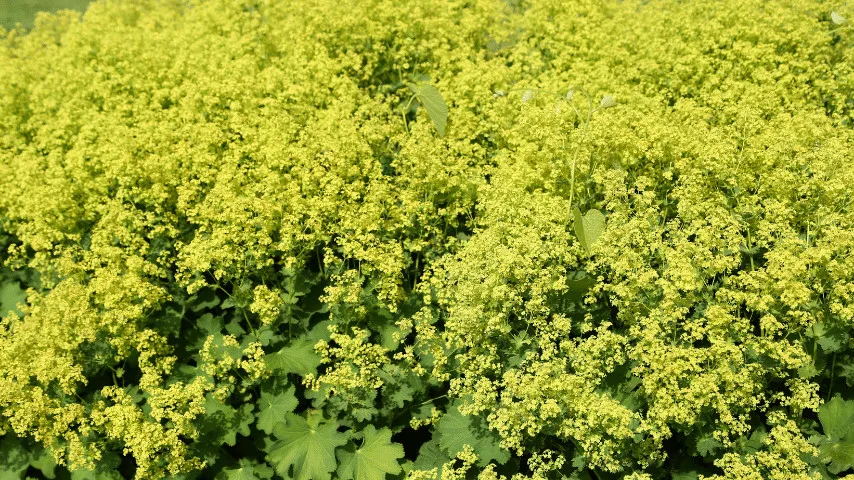
Alchemilla Mollis ideal cover for exposed shrubs and roses in outdoor clayey soil gardens and nurseries
Alchemilla Mollis, also known as Lady’s-mantle best suits in clay soil. Upon growing, it produces light greenish-yellow flowers during the early summer season.
Alchemilla Mollis acts as an ideal cover for exposed shrubs and roses in outdoor gardens and nurseries. You can plant it in either full sun or dappled shade, depending on the location.
Scientific Name and Nomenclature
- Scientific name: Alchemilla mollis
- Family: Rose
- Temperature: 59-68°F (15-20°C)
- Fertilizer: No fertilizers required
- pH: 5.5-7.5
- Lighting: From direct sunlight to diffused shadow
- Growth rate: Slow
- Humidity: Optimum moisture rate
39. Pulmonaria
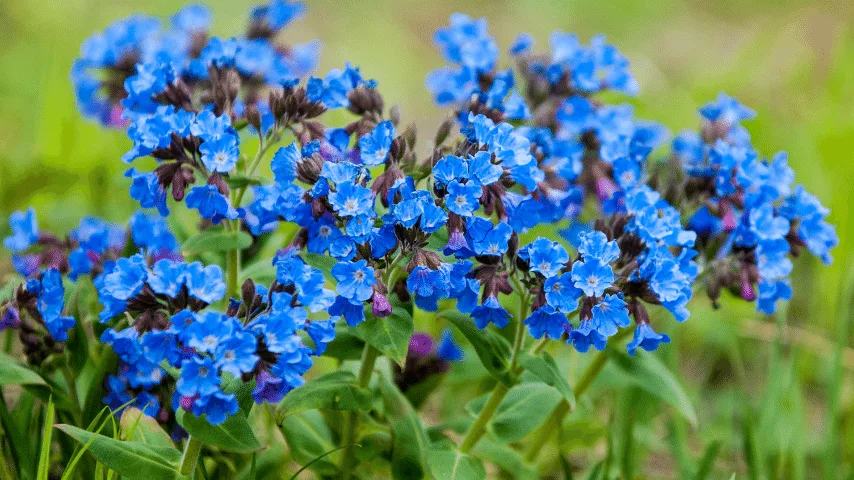
Pulmonaria adapted to clay soil, a shade-tolerant plant
Apart from being adapted to clay soil, Pulmonaria is a shade-tolerant plant. Secondly, it’s considered an ideal perennial plant due to its adaptation and growth.
It attracts bees, making your garden more bee-friendly and interactive. You can also trim its foliage before summer for a refreshing look.
If you are short on space and love growing Pulmonaria, then you can grow them in a shaded spot.
Scientific Name and Nomenclature
- Scientific name: Pulmonaria
- Family: Boraginaceae
- Temperature: 60-65°F (15-18°C)
- Fertilizer: Spraying all-purpose fertilizer is recommended
- pH: 4.5-7.5
- Lighting: Partial to shade
- Growth rate: Moderate
- Humidity: 65%
40. Ribes Sanguineum
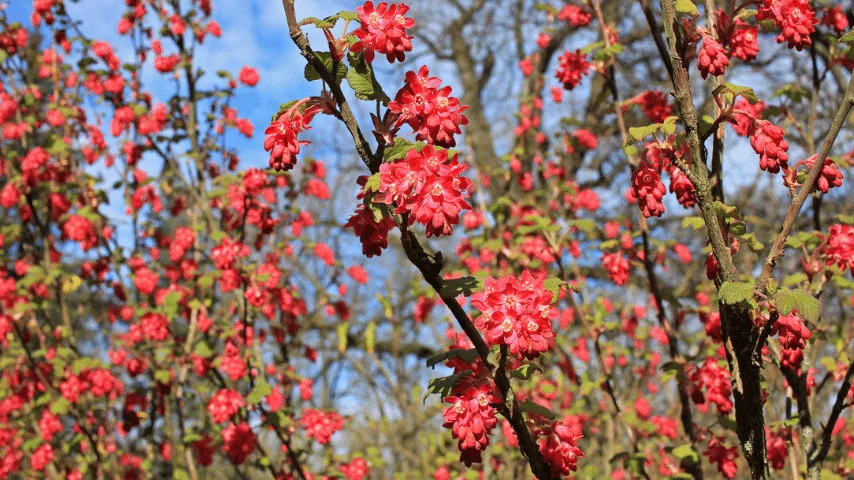
Ribes Sanguineum love staying in moderately moist and fertile soils like clay that offer much nutrition and fertility
Ribes Sanguineum is known for its attractive body structure and is described as red-flowering currant.
Ribes Sanguineum has the ability to grow up to 5-12 ft under ideal conditions.
They love staying in moderately moist and fertile soils like clay that offer much nutrition and fertility.
Scientific Name and Nomenclature
- Scientific name: Ribes sanguineum
- Family: Grossulariaceae
- Temperature: 34-38°F (1-3°C)
- Fertilizer: Nitrogen-based fertilizer for leaf growth
- pH: 5.0-6.5
- Lighting: Half shade
- Growth rate: Slow
- Humidity: Optimum humidity
Conclusion
Clay soil can hold moisture over a long period of time compared to gravel and sandy soil types.
It’s recommended to maintain certain humidity and temperature levels while planting tough species of seasonal plants.
At times, many amateur gardeners and hobbyists get confused about their plant’s soil requirements and subgrade conditions.
For many people, clay is considered an average soil type.
However, clayey soils provide maximum fertility and nourishment to plants which require decent moisture and fertility throughout the growing and thriving period.
You can grow the plants mentioned above in clay soil and get the best results.

![40 Best Plants for Clay Soil [2024]](https://plantophiles.com/wp-content/uploads/2022/05/Best-Plants-for-Clay-Soil-720x405.jpg.webp)
